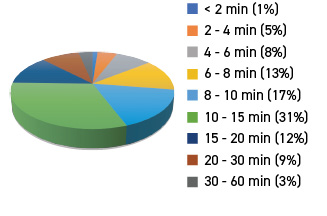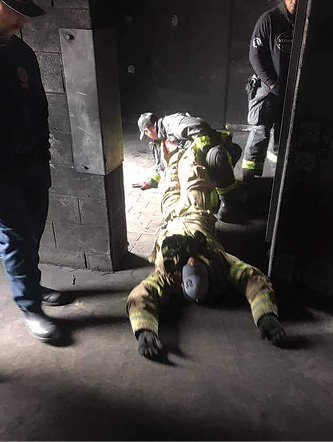BY SEAN DUFFY
Over the years, the fire service has done a tremendous job in providing quality training for residential primary search and rescue operations. The mindset of putting our civilians first, backed by educated and aggressive actions on the fireground, is something that will undoubtedly continue to save more lives. However, it is important to remember that search and rescue are two very different aspects of the overall mission, and locating the victim is only half the battle. The rescue truly takes place in the act of removing the occupants. This includes passing them off to waiting emergency medical services (EMS) crews, who will continue treatment and transport to further aid in their survival.
- Civilian Rescue: The Reason We Exist
- Tactical Supervision for Known Rescues
- Lessons Learned from a Civilian Rescue
- Aggressive and Practical Search: It’s Still About the Victim
The question, therefore, is, are we properly training to ensure that our search efforts coupled with our removal techniques and decisions are aimed toward the best possible outcomes? Are we training equally on removal so that we can be adequately prepared for the removal process, or are we hyperfocused on the search itself? If we can perform only one aspect of the equation, we are not giving our civilians the best chance to survive, and we probably shouldn’t be searching in the first place. We would be providing a disservice, not a service, to our mission (photo 1).

1. During search training in an acquired structure, students used the benefit of removing a real person from a window. This helps because a human body reacts differently than a hose dummy or mannequin and gives the students a more accurate and realistic gauge of their removal techniques. This training prepares individuals for the realities of victim removal and builds confidence in their abilities to accomplish a task in a situation when seconds matter. (Photo by Johna Denault, Second Alarm Fire Photography.)
Searchers must evaluate and understand many tactical considerations that can increase the survival odds for trapped occupants. Maintaining situational awareness of the incident and of the victim’s location in relation to the best removal point will guide rescuers in making the appropriate decisions that will increase the victim’s chance of surviving. Knowing how and when to implement certain tactics benefits civilians and firefighters in time-sensitive situations. When removing occupants, the searchers must be aware that those being rescued do not have the same protection from toxic smoke and heat as the rescuers. This is incredibly important in relation to the airway of the person being removed from the immediately dangerous to life or health atmosphere.
All movements should be focused on protecting the victim’s airway by keeping it as low as possible for as long as possible, providing the individual with the freshest and coolest air possible. The goal is to choose tactics that will lower the victim’s exposure rate. This can be done in many ways. Conditions will drive our tactics; the timing of suppression and ventilation in these scenarios is paramount.
Another consideration is isolation of spaces (when possible). Isolation by closing doors is critical to occupant survival rates and rescuers’ effectiveness.
Tactical Considerations
Let’s look at some tactical considerations that affect rescue operations.
Timing of suppression, search, and rescue. Speed and early isolation, when possible, determine the effectiveness of search and rescue operations. Searching with speed and efficiency will allow us to start the removal process in a timely manner. When arriving on scene, our time to task and the impact it has on potential trapped occupants must be top of mind. American Heart Association research has shown that for every minute a person is in cardiac arrest, survival odds decrease by 7% to 10%. Data sets from fireground rescues (Firefighter Rescue Survey) show that locating and removing a victim within the first eight minutes of arrival (total rescue time) resulted in a survival rate of 68%.
Further analysis has shown that 75% of rescues from the time of dispatch to complete removal of the occupant occur within 15 minutes or less. Statistics such as these prove the importance of remaining mission focused. Our arrival does not guarantee that the victims will survive. How we choose to access and extricate them makes a difference. This creates the mindset that time is our enemy and that we need to use speed as our weapon to deliver the best possible outcomes on the fireground (Figure 1).
Figure 1. Time from Dispatch Until Victim Removal vs. Total Recorded Rescues

This slide from the Firefighter Rescue Survey breaks down the data obtained from the first 3,000 documented rescues in relation to dispatch and victim removal times. (Source: Firefighter Rescue Survey.)
Remain disciplined! When we find a victim, it is of the utmost importance to remain disciplined and consider how we will remove the person as quickly as possible while keeping the occupant’s airway at the lowest functional elevation that will result in lower thermal and toxic exposure. Realizing that seconds count for the victims, do your best to perform suppression simultaneously with search and rescue operations. If this cannot be done because of a lack of skills or resources, this should be done as close to simultaneously as possible.
Keep in mind that whether suppression efforts are being performed from an interior or an exterior position, they will decrease thermal and toxic hazards for potential occupants and firefighters performing search and rescue operations. Remember that following effective suppression, you should ventilate on both the interior and the exterior to further facilitate the removal of combustion gases. Suppression alone does not accomplish this entirely. Effective suppression keeps conditions from getting worse, but ventilation is needed to improve conditions following suppression efforts.
Even when performing a rescue after suppression, it is still important to keep the occupant’s head low in the space because the smoke layer will remain in the structure until ventilation is completed. Recent studies from the UL Fire Safety Research Institute on search and rescue tactics in single-story, single-family homes have shown that removing an occupant lower in the space (one foot above the floor) resulted in a lower accumulated exposure compared to higher elevations (three feet above the floor), even if the higher elevation egress was completed at a rate that was three times as fast. This information makes it imperative that, when choosing our removal pathways and techniques, we ask ourselves the following questions: How fast can I perform what I am about to do? Have I trained on this before? Have I trained on this recently? Have we vetted this technique before this incident? Will this impact our crew’s safety, occupant survival, and the conditions within the structure (photos 2 and 3)?

2. One of the “dirty grab” techniques that can be used to keep the victim’s head as low as possible. This preferred method is called the “leg lock.” It gives the rescuer the advantage of being able to move the victim quickly while keeping a firm grip and still maintaining situational awareness. (Photo by author.)

3. Locking joints together when performing a victim drag allows the rescuer to maintain control of the victim’s movement, especially if the individual’s skin has been compromised. Maintaining a tripod position also ensures that the rescuer is more stable. (Photo by Joey Baxa.)
Presuppression isolation. This action has a great impact on saving lives and gives firefighters an incredible advantage. The latest update to the Firefighter Rescue Survey showed that in 30% of all recorded rescues, the victim was found behind a closed door and the survival rate was 82%. This not only proves the benefits of isolation, but it also confirms that educating our communities about the importance of closed doors will lead to better outcomes for trapped occupants and firefighters performing search and rescue operations. Keep in mind that an already isolated compartment not only serves as a place of refuge, but it also reduces the oxygen available to the fire and increases the oxygen supply to the occupant. It also lowers temperatures within the space by nearly 900°F. The supply of oxygen behind a closed door can be increased by as much as 18%; it increases even more with successful ventilation of the space. In a rescue operation, the choice of the removal pathway is critical to the occupant’s overall exposure rate and survivability, especially if the occupant was found outside of an isolated room. It is beneficial for rescuers to have a place of refuge to which they can quickly relocate occupants.
Presuppression removal. In the analysis of more than 3,000 documented rescues, it was found that 92% of all successful rescues were initiated before or simultaneously with fire knockdown, yielding a survival rate of 67%. You do not have to wait for suppression before initiating the rescue. Consider a removal pathway that does not pass the fire room if and when possible. Thermal and toxic exposures to the occupant are higher when bringing them past the fire. Such an environment can cause life-threatening conditions such as hyperthermia; body surface burns; respiratory tract burns; and an increase in body temperature, which, at 108.50F, can be fatal unless treated within minutes.
Choosing an alternate pathway will help to prevent these health hazards. Situational awareness and remaining oriented are paramount when determining an alternate route for victim removal. Choose the removal tactic you can confidently perform as quickly and effectively as possible with the resources available to you. Victims removed from the structure within four minutes after being located had a survival rate of 70%.
Delayed removal with isolation in protected space. In training, we tend to teach that we should grab and drag the victim to the closest exit. Although this is not necessarily wrong, we must ask ourselves an important question: Is it always best to remove an occupant as soon as we find one? Research has shown that in certain situations, immediate removal could potentially cause more extensive exposure to the occupant. In this case, we may want to consider the benefits of delaying removal if we are in an isolated space protected from fire. An example of this would be when the occupant is located but suppression has not yet started and the only other option for removal is to drag the victim past the fire. It may be best to consider delaying the removal until the fire attack crew can make progress so that the occupant will not have to be exposed to a higher-hazard environment.
Knowing this, we should choose an alternate pathway that will lessen these hazards to the people we are rescuing. These alternate routes of travel may not be the same as the pathway taken when you entered the structure, so keeping situational awareness and remaining oriented are paramount. You should choose the removal tactic that you can confidently perform as quickly and effectively as possible with the resources available to you right now. Victims that were removed from the structure within four minutes after being located had a survival rate of 70% (Figure 1).
If you choose to do this, remember that you are isolated from the fire and are ventilating the room you are in while keeping the victim’s head low in the space. When deploying this tactic, you are taking a moment to allow conditions to improve so that you can use the best option for removal. A delayed removal does not mean you are delaying getting an occupant to a better environment; it means the environment you are in is much better than the one to which you would take the victim. You are delaying because it is what is best for the occupant, but you should not choose this method if other safe removal options, such as windows, are available to you.
We Can All Do More
There are various considerations when talking about the removal of occupants. Nothing in this article is aimed at changing your department’s policies or telling you that how you currently approach victim removal is wrong. Regardless of the size of your agency or your staff, we all can do more to contribute to positive outcomes for our civilians. Everything starts with training, and we owe it to ourselves and the civilians we protect to train in how we will be operating. When training on victim removal, practice removal techniques under different conditions, in different levels of visibility, and on various types of surfaces. Put obstructions, preferably ones that would be commonly found in a residential setting, in the way so that you will have to navigate around them.
Create situations where those participating will have to think about and choose the best pathway for removal. Aim at improving communication with other crews performing different tasks such as fire suppression and get the status of their objective to assist in your decision making. Encourage open conversations about how your agency approaches victim removal and establish a way to measure your abilities so you can train for faster extractions and all members are on the same page. Our success is based on recognizing small windows of opportunity that can make a difference. We must seize every moment available to maximize our abilities for the best outcomes.
REFERENCES
Firefighter Rescue Survey. firefighterrescuesurvey.com.
“Close Before You Doze,” Fire Safety Research Institute, June 28, 2021. fsri.org/programs/close-before-you-doze.
“Report Release—Analysis of Search and Rescue Tactics in Single-Story Single-Family Homes Part I: Bedroom Fires,” Fire Safety Research Institute, May 17, 2022. bit.ly/3vEVDTs.
“Report Release—Analysis of Search and Rescue Tactics in Single-Story Single-Family Homes Part II: Kitchen and Living Room Fires,” Fire Safety Research Institute, May 17, 2022. bit.ly/47K93uH.
“Report Release—Analysis of Search and Rescue Tactics in Single-Story Single-Family Homes Part III: Tactical Considerations,” Fire Safety Research Institute, May 17, 2022. bit.ly/3u1vuho.
SEAN DUFFY is a 19-year veteran of the fire service and a firefighter for the Ann Arbor (MI) Fire Department. He has an associate of applied science degree in fire science and has instructed at conferences and training events locally, nationally, and internationally. He has published work in multiple trade magazines and is a cofounder of Build Your Culture LLC.
Sean Duffy will present “Searchable vs. Survivable: Educated Decision Making” at FDIC International in Indianapolis, Indiana, on Monday, April 15, 2024, 1:30 p.m.-5:30 p.m.

